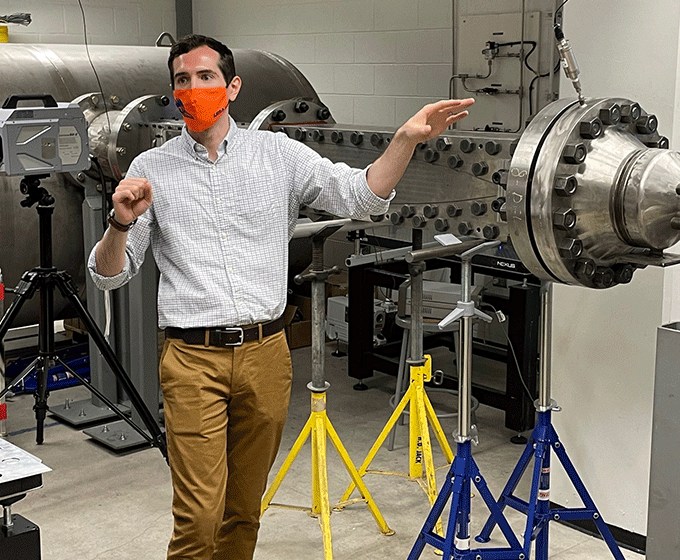
Aerodynamics professor Chris Combs and his team operate the new state-of-the-art Mach 7 Ludwieg Tube Wind Tunnel in the UTSA Hypersonics Lab. It's able to conduct a variety of tests under Mach 7 conditions, which is seven times the speed of sound.
OCTOBER 19, 2021 — UTSA’s investment in a million-dollar hypersonic wind tunnel is paying dividends with another innovative research opportunity in the works.
Christopher Combs, Dee Howard Endowed Assistant Professor of Mechanical Engineering in the UTSA College of Engineering and Integrated Design, recently secured a two-year, $1.5 million grant to study modeling and experimental measurements of hypersonic separation events.
The grant comes from the University Consortium for Applied Hypersonics (UCAH) in collaboration with the Texas A&M Engineering Experiment Station and the Joint Hypersonics Transition Office. UTSA is part of a group of leading research institutions that was awarded funding to advance hypersonic research.
Combs will be leading the project in collaboration with the University of Texas at Austin, the University of Tennessee, Southwest Research Institute and the Oak Ridge National Laboratory.
Combs is also the director of the UTSA Hypersonics Laboratory in the Department of Mechanical Engineering, which recently installed a 60-foot Mach 7 Ludwieg Tube Wind Tunnel. This technology enables UTSA to contribute important scientific findings on the effects of travel faster than the speed of sound.
Current computer models struggle to replicate the testing conditions in a high Mach number wind tunnel. UTSA’s Ludwieg Tube Wind Tunnel will capture and measure the aerodynamic effects experienced by motor stages, boosters or protective shrouds when they separate at hypersonic speeds. The findings from Combs and his student research team will help advance the design of aerospace vehicles traveling at hypersonic speeds.
“Separation events are such a complex part of the hypersonic flight challenge,” Combs said. “It’s exciting to use the state-of-the-art experimentation available in our Hypersonics Lab to build a database to help develop computational models that will improve vehicle design.”
The grant also provides for experiential learning opportunities at UTSA. One graduate research assistant position and two undergraduate research assistant positions at UTSA will be part of this project over the next three years with additional students funded at the partner institutions.
“The neat thing about this UCAH research is that this will be student-centric, and this project will help us train the next generation of leaders in hypersonic research while solving real-world problems,” Combs said.
“This research opportunity is another example of UTSA’s growing footprint in aerospace due to our investments in the Hypersonics Laboratory,” added JoAnn Browning, dean of the UTSA College of Engineering and Integrated Design. “Under Combs’ leadership, UTSA will be in a position to attract additional hypersonic-related funding opportunities, along with attracting top students to be part of the program.”
UTSA Today is produced by University Communications and Marketing, the official news source of The University of Texas at San Antonio. Send your feedback to news@utsa.edu. Keep up-to-date on UTSA news by visiting UTSA Today. Connect with UTSA online at Facebook, Twitter, Youtube and Instagram.
Move In To COLFA is strongly recommended for new students in COLFA. It gives you the chance to learn about the Student Success Center, campus resources and meet new friends!
Academic Classroom: Lecture Hall (MH 2.01.10,) McKinney Humanities BldgWe invite you to join us for Birds Up! Downtown, an exciting welcome back event designed to connect students with the different departments at the Downtown Campus. Students will have the opportunity to learn about some of the departments on campus, gain access to different resources, and collect some giveaways!
Bill Miller PlazaCome and celebrate this year's homecoming at the Downtown Campus with food, games, giveaways, music, and more. We look forward to seeing your Roadrunner Spirit!
Bill Miller PlazaThe University of Texas at San Antonio is dedicated to the advancement of knowledge through research and discovery, teaching and learning, community engagement and public service. As an institution of access and excellence, UTSA embraces multicultural traditions and serves as a center for intellectual and creative resources as well as a catalyst for socioeconomic development and the commercialization of intellectual property - for Texas, the nation and the world.
To be a premier public research university, providing access to educational excellence and preparing citizen leaders for the global environment.
We encourage an environment of dialogue and discovery, where integrity, excellence, respect, collaboration and innovation are fostered.